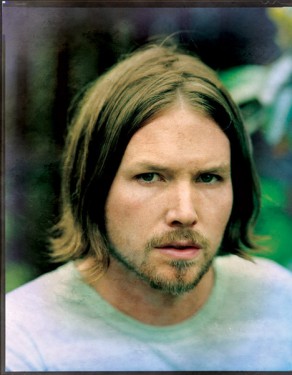 Back to selection
Back to selection
25 NEW FACES – PART 4
Brent Stewart

When you live next to Harmony Korine some unconventional ideas can creep into your head. So when Brent Stewart was thinking about making a chamber-piece drama on 35mm and shooting the whole thing with little to no camera movement he went to his famous filmmaking neighbor for some advice.
“I knew it would be a challenge to pull off because even Harmony said to me, ‘Man, that’s risky.’”
But, The Colonel’s Bride, Stewart’s debut feature, is an intimate look at loneliness, old age and death with striking photography, a haunting score and a stirring lead performance that shouldn’t be missed. In the film, we follow Bill (character actor James DeForest Parker), a Vietnam vet who awaits the arrival of his mail-order bride (Alicia Truong). With a regular diet of booze and cigarettes, Bill is a grizzled guy from a different era. Though Stewart doesn’t delve into the pain in Bill’s eyes, it’s obvious he’s seen a lot in his life and is still digesting it all; and by the time he’s content the end is suddenly upon him.
For Stewart, 35, the creation of Colonel’s Bride is a culmination of years struggling in the avenues of fine art and photography. Searching to find “comfort in narrative stories,” he attended Rotterdam’s CineMart when he was selected in 2007 in hopes to get his footing in the film world. “I was meeting with production companies from all over the world, but they were like, ‘Let’s make a film in Belgium.’” Frustrated, he went back to Nashville and began making shorts, including the ’09 Sundance entry The Dirty Ones. Then last year he scrounged enough money through a mixture of sporadic jobs, selling his still photography and working as a second-unit director for one of Korine’s Liberty Mutual commercials (where he met Parker) to make Colonel’s Bride. He also obtained his 35mm film through short ends his AC got from shows like Lost, Grey’s Anatomy and the movie Gran Torino. “Economy of means,” is how Stewart describes the making of the film. But soon after filming it seemed his hard work would be for naught. Rejection letters from festivals began to pile up, including Sundance, SXSW and Rotterdam. Stewart, however, took it in stride. “The Colonel’s Bride is a different kind of movie,” he says. “It’s not mumblecore, it’s not hipster, but that’s why I made it. I wanted to go back to basics.”
Finally in April the Sarasota Film Festival premiered the film followed by the Nashville Film Festival, where it received a jury prize. Variety critic Joe Leydon was impressed by Parker’s “controlled but compelling mix of sad-eyed courtliness and alcohol-fueled self-loathing,” calling it a remarkable lead performance. Stewart hopes to ride this momentum into the fall festival season.
Stewart also hopes The Colonel’s Bride will shine a light on the film scene in Nashville. Along with Korine shooting his latest film, Trash Humpers, there, Stewart and his friends are also producing films in the area through the company they started, Nomadic Independence Pictures. Having already produced Bride and three other features in the last year, they’re currently prepping the next film by Michael Tully (Silver Jew, Cocaine Angel). “We’re able to do things here that are difficult elsewhere,” Stewart says. “And it’s just great to collaborate with friends that you trust.” — Jason Guerrasio
Contact: flemingstewart at hotmail dot com; http://vimeo.com/user1031595
Jade Healy

- JADE HEALY. PHOTO BY NOAM CHRISTOPHER
“I once had a director cry when she walked through the main character’s set because she was so moved. That was definitely one of the most rewarding moments for me as a designer.” In the past few years, production designer Jade Healy’s hands have touched a diverse selection of notable independent films: Ti West’s House of the Devil, Zeina Durra’s The Imperialists Are Still Alive!, Sundance success happythankyoumoreplease and Joe Swanberg’s Alexander the Last. She began in production, as an assistant producer on Asia Argento’s The Heart Is Deceitful Above All Things, after interning for Muse Production’s Chris Hanley; next she worked on Edmond, handling the delivery of the film to the distributor, and then produced M. Blash’s Lying in upstate New York — but she wasn’t sure that producing was the road she wanted to take. “I had a love/hate relationship with producing — I was so grateful to be working in film, but the stress and fear was overwhelming. I still get nervous checking my voicemail.”
When the chance came to work for free in the art department on a tiny film called The Blue Hour, Healy jumped on it. From there she went on to be the decorator on Cabin Fever 2: Spring Fever, with Ti West, and West then brought her onto his retro-horror feature House of the Devil as his designer. Three years later, she has just completed West’s The Innkeepers, along with half a dozen other projects.
In between design jobs, Healy took a vacation to Costa Rica with her friend Kris Swanberg along with d.p.s David Lowery and Ben Kasulke. The resulting film, It Was Great, But I Was Ready to Come Home, co-directed by she and Swanberg, premiered at SXSW 2009. Healy and Swanberg also starred in the film as two friends on vacation. Healy has since been writing and plans to finish several scripts during her next break between movies, but admits that it’s hard to find time: “I always say I’m going to stop, and then something else comes along.” She was brought up as a hands-on, grab a paintbrush type of designer, and says that her willingness to do hard labor has sometimes surprised crew used to working on larger budgets.
She’s learned some things over the years: “Just because something looks amazing doesn’t mean it’s right for the character, or the film. I like to think I have learned to practice more control. My goal is always to create sets that help push the narrative forward, not distract from it.” Does she feel limited working with the sometimes miniscule budgets of indie films? “Not limited, per se — it’s amazing how far you can stretch a dollar — though sometimes I get sad that I’ve memorized every curtain style on offer at IKEA.” — Alicia Van Couvering
Contact: Mira Jong at Gersh: (212) 997-1818
Sultan Sharrief

- SULTAN SHARRIEF.
Made piecemeal over four years, Sultan Sharrief’s Bilal’s Stand is a brazenly autobiographical, starless, penny-pinching production from Detroit about one black Muslim teen’s decision to go to the University of Michigan despite the naysayers in his family as well as in the diverse, suburban high school he treks to instead of the more toxic Detroit public high school nearby. Rough around the edges, it’s told with enough freewheeling inventiveness and first-person verve that it transcends its obvious financial limitations and offers a glimpse of utterly authentic working-class black life in the industrial Midwest. In the world of cinema, studio or independent, this might as well be Mars. “A lot of people are getting excited about film as a potentional new industry in the Midwest,” its twenty-something director told me during a recent phone conversation, “and although we plan to have more money in the future, we want to work in the same way, involving the community and young people in the film.”
High-energy affairs that deal with young men from rarely represented, strict and insular communities who try to rise out of their circumstances to pursue their desires, familial responsibility be damned, have been hot the past few years (uh… Slumdog Millionaire), but none has seemed quite this uniquely grounded in the filmmaker’s actual hometown. Mixing non-actors, often playing themselves, with trained performers, the film uses a consistent voiceover from Julian Gant’s protagonist with incredibly witty animations over the live-action footage to illustrate Sharrief’s singularly perceptive and often highly comic worldview.
Sharrief employed a cast and crew made up mostly of new actors and local kids who have been a part of the Student EFEX Project (Encouraging the Filmmaking Experience), a partnership between local Detroit artists, students from the University of Michigan, and metro Detroit high schools to teach and encourage film production among the young. In the aftermath of the impressive festival run of Bilal’s Stand, which has included trips to Sundance, Berlin and ND/NF, Sharrief is working on a couple of different projects, including a film about how the health-care system is failing the young. He’s also hoping to catapult his organization into a full-fledged Detroit-based production company, fellowship program and movie studio. “I envision developing something akin to the Sundance Institute here in Detroit, where we could develop artists. There’s a lot of interest in that here.” — Brandon Harris
Contact: asst at beyondblueproductions dot com
Mike Stoklasa
In December 2009, Mike Stoklasa uploaded Star Wars: The Phantom Menace Review, a 70-minute takedown of George Lucas’s 1999 film. Astute in its critique, perverse in its use of humor and hypnotically narrated in the first person by a serial killer character in severe need of a decongestant, the review used footage from the film, its DVD extras and the occasionally third-party source to systematically prosecute Lucas’s crimes against filmmaking and his betrayal of Star Wars fans’ pent-up devotion.

Once posted, the video went viral. Lost co-creator and Star Trek producer Damon Lindelof gave it immediate mainstream cred at Slashfilm: “Your life is about to change,” he told viewers. “This is astounding filmmaking. Watch ALL of it.” Lindelof was joined by actor Simon Pegg, who raved about the film on his Twitter feed. In one day, Stoklasa’s film garnered 30,000 views. Six months later, it has hit 2.2 million.
Despite all the attention, Stoklasa himself remained something of a mystery. But in fact, the Milwaukee-based filmmaker has been making ultra-low-budget features — “talking food” comedies like Oranges: Revenge of the Eggplant, and a psychological thriller, The Recovered (co-directed with Jay Bauman) — since graduating from Chicago’s Columbia College in 2002. (And that’s not even mentioning his Internet comedy series, The Grabowski’s, where the gimmick, he says, “is that the episodes are really short — like five seconds long.”) It is the Star Wars takedown, though, Stoklasa’s exciting filmmaking left turn merging viral video, short-form storytelling and film criticism into something that feels totally new, that has brought him to greater attention and this “25” list.
While Lindelof, Pegg and the rest of us discovered Stoklasa last winter, he actually began this experiment in cinematic deconstruction a year earlier after he bought a copy of Star Trek: Generations. “I wrote pages and pages” of a review, Stoklasa says. “I started recording it, and it was horribly boring. So I [invented] a character so it would have more entertainment value. Then I started throwing in comedy bits. I did all the Next Generation films throughout 2009, and then the next logical thing was to do the Star Wars prequels.”
“I’m one of that generation that grew up on the Star Wars movies,” Stoklasa continues. “I remember seeing the Phantom Menace two weeks before it officially opened at a trade screening, and I was bewildered by what I saw. I decided to look at the film more from a ‘fascinating train-wreck perspective’ than a ‘passionate Star Wars fan’ perspective. I like to figure out why these movies don’t work. It’s more of an analytical approach.”
Stoklasa’s series continued in the spring of 2010 with a similarly obsessive feature-length Episode Two: Attack of the Clones review. And then, in mid-June, 2010, Stoklasa — or, rather, “Plinkett,” the fictious creator of these pieces — threw another change-up: a review of the barely remembered, John Hughes-scripted 1994 film, Baby’s Day Out. Meanwhile Stoklasa continues working at his video-production company, Red Letter Media, which does freelance corporate work and shoots for Marquette University. Career-wise, “The [reviews] have led to a lot of interesting leads, but nothing concrete has come of them yet,” he says. “I met with an agent and some big websites have contacted me. But I don’t consider myself a reviewer, and I don’t know if I’d want a show reviewing movies every week.” Until the urge to demolish another poorly-conceived, logic-busting mainstream film hits him, Stoklasa is working on his next feature, Feeding Frenzy, “a low-budget, ’80s-style comedy rubber-puppet monster movie, like Gremlins and Goonies.” — Scott Macaulay
Contact: redlettermedia.com; redlettercontact at gmail dot com
Kasper Tuxen

- KASPER TUXEN.
“I started out as a child actor,” says Kasper Tuxen, the Danish d.p., who has in the space of a year become sought after by American independent directors looking for adventurous cinematic collaborators. “I was 13; I had a lead role in a Danish film, but from the first day of the shoot I was interested in cinematography.” When he got older Tuxen thought about becoming a rock musician but enrolled in the Danish Film School in Copenhagen instead. “It was a very technical education,” Tuxen says. “For four years it was all about film and exposure.”
After film school, Tuxen says, “it was hard to break into narrative. I only got one feature film in five years.” So he started to shoot music videos for director Martin de Thurah and bands like Fever Ray and Röyksopp. As can be seen on his reel (lspagency.net/dp-folder/tuxen.html), these are some of the most gorgeous clips around, dreamy and painterly and with textures far away from standard-issue American music videos. Not surprisingly, Tuxen’s other major work during this period was in the art world as a d.p. for 17 of Danish artist Jesper Just’s pieces.
Tuxen, now based in New York, credits agent Rebecca Fayyad of Sheldon Prosnit Agency for bringing him to the States. “She called me and started the dream way earlier than I thought I could have it. It took me two years to believe her [that I could get work in the States].” The film that finally lured Tuxen here was Eric Mendelsohn’s Sundance Dramatic Competition film, 3 Backyards, in which the d.p. visually reimagined the suburban ensemble drama. Wrote the Sundance programmers, “With its unconventional visual style, 3 Backyards looks and feels like a film from another time — possibly the past or the near future.” Three more features quickly followed, including Mike Mills’s follow-up to Thumbsucker, Beginners and M. Blash’s second feature, The Wait.
Tuxen, who cites fellow d.p.s Harris Savides, Anthony Dod Mantle and Nestor Almendros as inspirations, says that he’ll often start to think of still photography when first contemplating a scene. “I’ll think, if we only had one setup for a scene, one shot, what would that photograph be? It might be a close-up, or you might shoot it from half a mile away. I also like to work with natural light. I’ll watch how the light behaves in a room during the day, and then later remember it and maybe add a little more light on top.” Although Tuxen has shot film for much of his music video and commercial work, his features have all been on HD video (mostly the RED), and that’s okay. “The lightness of the camera, the possibility of long takes….” he muses. “I truly love handheld, and I like to operate and pull focus myself. I’ll shoot a close-up with a 35mm lens so I’m as close to the actors as you would be in a conversation with a close friend.” It’s the ability to achieve that sense of intimacy that keeps Tuxen committed to independent film. “It’s hard to have that intimacy with a big crew. [On larger films] the creativity has to be in preproduction. I like to respond to a scene when it’s happening.” — S.M.
Contact: Rebecca Fayyad at Sheldon Prosnit Agency: (310) 652-8778
